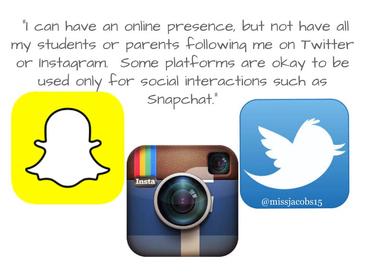
After watching Casey Neistat’s YouTube video Instagram i love you, I believe it is important to maintain an online presence as an educator. Right now I have a Twitter and Instagram account that I will be using professionally as an educator. I’ve been using Twitter regularly but now I need to start utilizing Instagram to see what it can offer. Obviously pictures are more interesting to look at than text, but can it help educators connect as well as text? It’s my job as a leader to seek out this information and make contributions of my own. Neistat (2012) points out that “Instagram is not about the pictures, it’s about the sharing.” Instagram allows you to see into the lives of really interesting people. Neistat recommends that users find a theme and document it. This is identical to Kleon's idea as well. He even states "Become a documentarian of what you do" (Kleon, 2014, p.41). The theme that I am the most comfortable with and the one I’m the most interested in is education. I am hoping I can share and connect with others about education. Learning from others will provide me opportunities to share ideas I’ve learned online to my school site and take a leadership role.
George Couros’ article Snapchat and Education (2014) outlines how it is important to maintain an online presence as an educator, but that there can still be limits. He started the article by trying to provide examples of how you can use Snapchat in the classroom. He had tweeted this question and got many answers, but one answer that stood out to him was that students think of Snapchat as an adult-free platform so it should stay out of the classroom. This is true to some extent. I think students know that adults use Snapchat because I have used it on field trips to send pictures and video to my colleagues who weren’t there. My students thought it was cool, but did not act really surprised that I had Snapchat. I do think they would think it was strange to use it in the classroom. This is where I think the limits of maintaining an online presence may be. I can have an online presence, but not have all my students or parents following me on Twitter or Instagram. Couros (2014) states “I also don’t think we need to invade every space that kids are on.” I agree. Some platforms are okay to be used only for social interactions such as Snapchat. However, I do think it’s a good idea to figure out why students enjoy these apps so much. Allowing students to connect to each other is probably one of the most meaningful ways they can learn. Therefore, allowing them to connect about class or during class would be great. I plan on setting up a Google+ community for my classes once school begins and allow them to share and post things about school to form a collective learning network amongst themselves. This will allow them to maintain an online presence, but also limit their sharing to the topics that are relevant to share about. I do not want students posting personal pictures to the community. Sharing is important and can lead to wonderful learning and leading opportunities, but limiting sharing is also valuable to maintain boundaries between students and teachers.
Resources
Couros, George. "Snapchat and Education." The Principal of Change. 27 Oct. 2014. Web.
15 July 2015. <http://georgecouros.ca/blog/archives/4866>
Kleon, Austin. Show Your Work!: 10 Ways to Share Your Creativity and Discovered. New York,
NY: Workman, 2014. Print.
Neistat, C. (2012, October 2). Instagram i love you. [Video file] Retrieved from
<https://youtu.be/GacoqdKjVyE?list=PLbRLdW37G3oMquOaC-HeUIt6CWk-FzaGp>